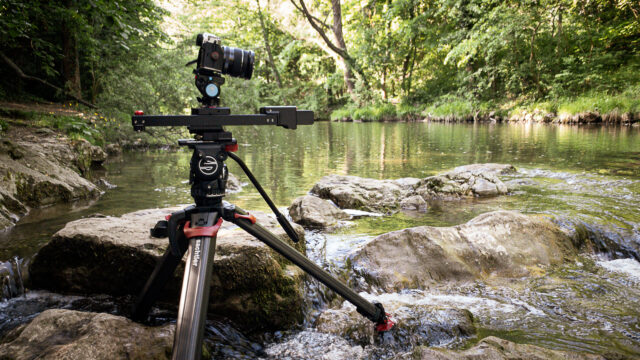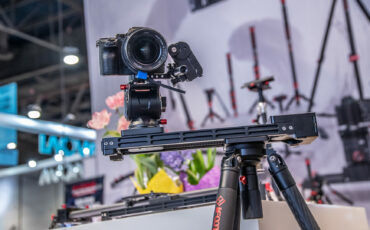iFootage Shark Slider Nano Review
Controlled camera movements add production value to all kinds of shots: interviews, establishers, packshots, architecture — just to name a few. One way to add motion to a shot is by using a slider. Let’s take a look at the iFootage Shark Slider Nano in this review. What’s special about it and what can it do? Read on!
Johnnie already had a First Look at the Shark Slider Nano a while back. He had some issues with the boot/calibration process and the app back then. While the hardware had already been finalized, the firmware was not. Most of the issues were ironed out via upgrades in the meantime. iFootage has even made some tutorial videos to clarify some aspects of the slider’s operation.
Build quality & specs
The build quality is very solid. All the threads are steel-reinforced and the rails and cables are placed on the inside of the body for protection. The slider has a built-in spirit level and two adjustable table-top feet. A knob locks the carriage on the tracks for transport. And it sports a combined 3/8th and 1/4 inch mounting screw. Awesome: The rotation of the pan axis can be locked, so it does not twist when you attach the head.

Power can be supplied with Sony NP-F type batteries, or via USB-C, which allows battery hot-swapping.
You can use the slider as-is on a table-top and slide the camera around 200mm, or mount it on a tripod. This way you can double the travel distance to roughly 400mm. On the Desktop the slider can carry loads of up to 3,5kg and 2,5kg on a tripod. Mounted vertically it lifts loads of up to 2kg.
Cinematic Timelapse with Drew Geraci
Controlling the slider
There is an app called iFootage Moco for iOS and Android devices, to update the firmware and control the slider’s functions. In Smartphone mode the app controls the slider and acts as a camera at the same time, which explains the included Phone mount. In camera mode, the phone only controls the slider, while a camera does the filming.
The Slider supports three useful shooting modes: Time-lapse, Video, and Stop-Motion.

No phone needed!
The great thing about the Nano is that it is controlled via its built-in touchscreen.
After switching the Slider on, it runs through a little calibration routine and is ready to go in a very short time.
The quickest way to get going is by pressing both buttons on the slider, which puts it in Quick Start mode and lets you frame the start of the shot quickly by sliding and panning the camera accordingly, touch A to save the position, line up the end of the shot, touch B and confirm. You can dial in the duration, touch start and the slider executes the move. Boom! Done! With the touch of a symbol, you can reverse the move and by touching another symbol you can tell the slider to go into loop mode.

With a compatible camera, the slider will also release the shutter in time-lapse and stop-motion mode with one of the five supplied cables. The slider is not completely silent, but quiet enough to use during an interview.
Downsides
There are downsides to the slider. The worst of which is the display. While it’s awesome indoors or in shadow, it’s extremely hard to see anything in daylight let alone in bright sunlight.
Also, sometimes the motion of the slider gets a bit jerky, especially when traveling very slowly. Adjusting the tension of the carriage with two knurled knobs mitigates this.

However, these are so hard to turn, that my fingers started hurting. To use the slider on a tripod, you need to select a sturdy tripod, so it does not flex or tip over and that impairs portability. While it is not a flaw of the slider itself, please keep it in mind.
What’s in the box?
The Shark Slider Nano comes with a soft carrying case, an USB-C charging cable, a Sony-style NP-F battery, five different shutter cables, and a smartphone mount.

Conclusion
The Shark Slider Nano is not the smallest kit available, but it IS still very portable. It’s quick enough to set up with a small crew or even on your own. The controllable pan axis gives you many creative options, including keeping an object centered, while sliding. For example a talking head in an interview.
The Shark Nano is a well-rounded package. This and the fact that it can be completely controlled by the built-in touchscreen makes it one of the best motorized sliders I have used so far.
What are your thoughts on the iFootage Shark Slider Nano? Would you consider using it for one of your shoots? Let us know in the comment section below!





























